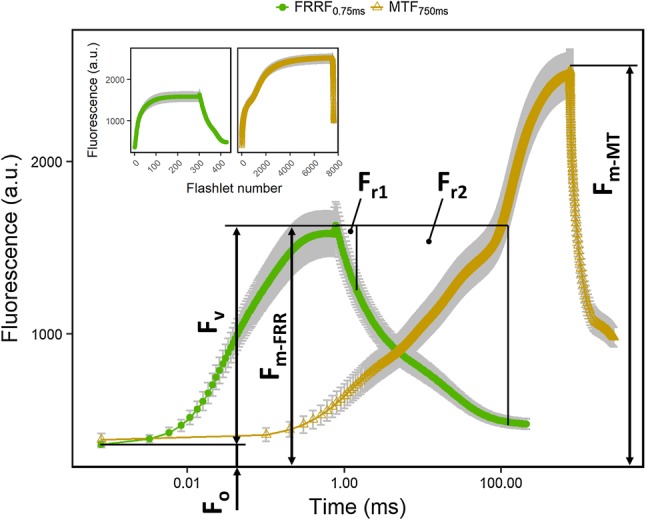Fig. 1.

Chlorophyll fluorescence transients of spinach leaves induced by fast repetition rate flash (FRRF0.75ms) and multiple turnover flash (MTF750ms) are presented on a logarithmic time scale. The FRRF0.75ms protocol (green circles) consists of 300 subsaturating flashlets (40,000 µmol photons m−2 s−1) in the first 0.75 ms to saturate maximum fluorescence (Fm−FRR). Minimum fluorescence (Fo), Fm−FRR, and variable fluorescence (Fv) were used for calculation of the quantum efficiency of photosystem II (Fv/Fm) in the dark-adapted state. The excitation flash is followed by 127 flashlets at exponential decreasing repetition rate resulting in chlorophyll fluorescence relaxation. The area above this relaxation curve was restricted by two time period (r1 = 0.65 ms and r2 = 120 ms after Fm−FRR was reached) resulting in two relaxation phases (Fr1 and Fr2). The areas were normalized with the corresponding time period and with Fv in order to retrieve the reoxidation efficiency of the primary quinone acceptor (QA) in the given relaxation phases (Fr1/Fv and Fr2/Fv). The MTF750ms (yellow triangles) protocol consists of 7500 subsaturating flashlets (1000 µmol photons m−2 s−1) in the first 750 ms and induced the maximum fluorescence (Fm−MT). Inset: Chlorophyll fluorescence transients against flashlet number of FRRF0.75ms and MTF750ms are shown. Error bars show standard deviation of the mean (n = 6 plants). (Color figure online)
